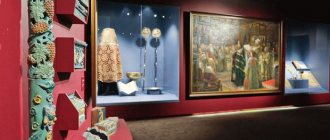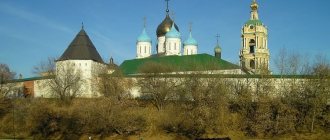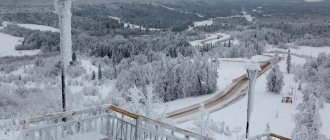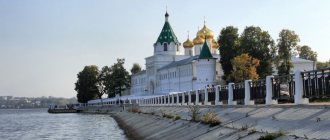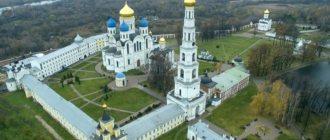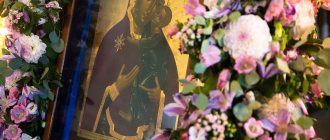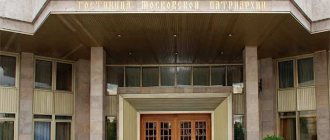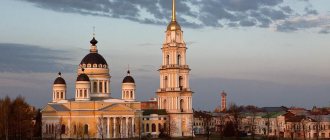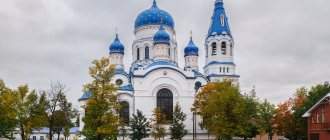"Save me, God!".
Thank you for visiting our website, before you start studying the information, please subscribe to our Orthodox community on Instagram, Lord, Save and Preserve † - https://www.instagram.com/spasi.gospodi/. The community has more than 60,000 subscribers. There are many of us like-minded people and we are growing quickly, we post prayers, sayings of saints, prayer requests, and timely post useful information about holidays and Orthodox events... Subscribe. Guardian Angel to you!
The Resurrection New Jerusalem Monastery is one of the most revered and popular communities located in the central part of the Russian state, and its distinctive feature is that the Resurrection Church located here was built in the likeness and image of the Cathedral of the Holy Sepulcher on Calvary (Jerusalem). However, in appearance, these two communities are completely different from each other. But you can find out how to get to the monastery, the schedule of services, what shrines there are and much more from this article.
How to get there
You can get to the monastery by train, bus or car. The train ride will take approximately 50-60 minutes. You need to get off at Rizhskaya, Dmitrovskaya, Voykovskaya or Tushino stations and get to Novoierusalimskaya. Now you can get to the monastery by minibus or walk.
A trip by bus No. 372 from Moscow (Tushino metro station) to the Pochta stop in Istra will take approximately 60 minutes. You can walk to the temple in 15-20 minutes.
The trip by car will take about 40-60 minutes. You can get there along the Volokolamsk Highway, bypassing Krasnogorsk and across the Pesochnaya River. If you drive from the Moscow Ring Road along the Novorizhskoye Highway, then at the turn to the city of Istra you need to move onto the Volokolamskoye Highway and then move to the monastery. If the parking lot at the front entrance is occupied by vehicles, you can drive to the larger parking lot at the western gate.
History of the New Jerusalem Monastery
The New Jerusalem monastery in the vicinity of Moscow was planned by Patriarch Nikon as a similarity to the Church of the Holy Sepulcher in Jerusalem. The Resurrection Heath was purchased from the patrimonial owner Bobarykin, on which the construction of the temple began in 1656.
After the purchase of the necessary lands from the patrimonial owners and boyars, the area was cleared of forest, and the first wooden buildings appeared in the form of the Resurrection Church and the fortress wall. In 1657, in the presence of Tsar Alexei Mikhailovich, the church was consecrated by Patriarch Nikon. The Resurrection Cathedral was started in 1658 and its construction continued until 1666 under the supervision of the patriarch.
Due to Nikon's exile to the Ferapontov Monastery, construction of the temple stopped for some time. The resumption of work was continued under Tsar Fyodor Alekseevich and with the help of the Workshop Chamber. In 1685, the construction of the temple was completed. Although the tsar allowed Nikon to return to the monastery in 1681, he died on the way.
His body is buried in the Cathedral of the Resurrection of the Lord, at the location of the chapel of John the Baptist.
In 1684, management of the monastery was transferred to the Order of Detective Affairs and, under the reign of Tatyana Mikhailovna and Sofia Alekseevna, the Church of the Nativity of Christ was built along with the refectory chambers and consecrated in 1692. In the 18th century. under Peter I, the monastery's funding was reduced, and it was forced to supply the state with horses, provisions and peasant workers.
During the reign of Elizaveta Petrovna, funds in the amount of 30,000 rubles were allocated. for the renovation of the monastery. Since 1762, several fires occurred within the walls of the temple, and Empress Catherine II had to eliminate their consequences. In the 19th and early 20th centuries. The monastery becomes a center of pilgrimage for believers thanks to the construction of a railway line.
By 1913, the number of pilgrims who visited the New Jerusalem Temple amounted to 35 thousand people a year. In 1919, the Temple was closed, and a historical museum was created in it by the Soviet authorities. In 1941, Nazi troops destroyed the main buildings of the monastery and blew up the Resurrection Cathedral. Only in 1959 did the museum continue its work and its buildings were restored.
The New Jerusalem Monastery resumed its activities in 1994 and in 2012 the museum was moved from the territory of the holy monastery to a new building.
In 1994, the activities of the New Jerusalem Church were resumed, and in 2012 the museum was moved from the territory of the holy monastery to a new building.
The royal journey in the footsteps of Patriarch Nikon
In April 1903, a groaning train delivered Emperor Nicholas II and his wife Alexandra Feodorovna to the Resurrection New Jerusalem Monastery to celebrate Easter. The royal couple arrived at the New Jerusalem railway station, opened in 1897. In 1901, a new platform was built, calling it “Istra”. The railway route shortened the travel time by 3-4 times; before this, pilgrims used the Nikolaevskaya road, which led to the Kryukovo station, where they had to change to a carriage and shake over bumpy bumps, admiring the scenery. Currently, a commuter train covers the distance from Moscow to Istra in 1 hour and 15 minutes. By paying 308 rubles for a round-trip ticket, you can relax and immerse yourself in history.
To New Jerusalem by train
The future Patriarch Nikon was born in 1605 in Mordovia. In the world his name was Nikita. His mother died early, and his father married someone else, who became an evil stepmother for the little boy. A difficult childhood, frequent beatings and hunger forced Nikita to run away from home more than once. He sought protection, shelter and consolation within the monastery walls. At the insistence of his parents, Nikita got married, but soon decided to take monastic vows. From that moment on, Nikon’s brilliant “career” began, and after some time a rapprochement with Tsar Alexei Mikhailovich began. In 1652, Nikon was enthroned as the Patriarchs of Moscow and All-Russia. At the same time, he managed to obtain the king’s promise not to interfere in the affairs of the Church. The era of reforms and changes has begun. Nikon sought to bring Russian Orthodox rites into line with Greek ones, including, he prescribed baptism with three fingers. All this led to a split in the Church into supporters of Nikon (“Nikonians”) and Old Believers.
Current state
In 2008, the New Jerusalem Monastery in the Moscow region found a new abbot, Hegumen Theophylact (Bezukladnikov), approved by the Holy Synod. Soon, Patriarch Alexy II and the country's President D. Medvedev visited the temple, which served to establish a Board of Trustees to resolve all issues regarding the reconstruction and arrangement of the monastery.
The Patriarch declared that the monastery should develop as a center of spiritual, educational and social culture. The president also signed a decree to provide comprehensive assistance in recreating the historical image of the monastery.
By 2014, the bell tower with new bells near the Resurrection Cathedral was restored, and 2016 marked the end of restoration work. They cost the state 10 billion rubles, part of which was taken from public donations.
Life today
Now the entire complex has been recreated almost in its original form. Daily services are held here. Nearby there is a museum complex bearing the same name as the monastery, which once occupied its territory.
Fairs and festivals
They are held on the territory of the museum complex. For example, at Christmas 2022 the following events took place here:
- folk culture festival; pavilions with products of folk craftsmen worked, animators held holiday programs, a skating rink and an ice slide worked;
- an agricultural fair where you could buy a variety of farm products.
Abbots (vicars) and brethren
The first governor of the monastery was Archimandrite Nikita (Latushko) . Since 1993, it was he, on behalf of Patriarch Alexy II , who negotiated with the authorities about the return of the shrine. The priest was the vicar until 2008. Since that time, the brethren has been headed by Archimandrite Theophylact (Bezukladnikov).
Resurrection Cathedral
The main part of the monastery is the Resurrection Cathedral, consisting of the Church of the Resurrection, a chapel with the Holy Sepulcher and the Church of Constantine and Helena, which goes 6 m underground. The central part of the temple has a four-pillar structure connected by a dome at the top. The vault of the dome depicts Jesus Christ ascending to heaven.
On the western side of the cathedral there is a huge rotunda, covered with a large dome that goes into the sky. In its center there is a cuvuklia or chapel with the tomb of Jesus Christ, decorated with divine tiles of the holy elders. In the very center of the dome, at its arch, the Lord God is depicted with Jesus Christ on the right side and the Holy Spirit in the form of a dove, surrounded by angels.
Description
From a bird's eye view, the New Jerusalem Monastery looks like a well-fortified fortress rising on a hill, in the central part of which the golden-domed Resurrection Cathedral is located. Its tent-shaped dome with 60 windows can be called the hallmark of the monastery.
In the Resurrection Cathedral, as in the Church of the Holy Sepulcher in Jerusalem, there are three main shrines of Christians:
- Golgotha is a small rock where Christ was crucified (translated from Greek the word “Golgotha” means place of execution)
- Edicule - a small chapel with the Holy Sepulcher, the burial place of Christ
- Church of the Resurrection of the Savior, the place of the life-giving Resurrection of Jesus Christ.
Golgotha, the site of the crucifixion of Christ, is located on the second tier of the temple; a staircase leads to it, located to the right of the main entrance. In a small room there is a cross made in Jerusalem and matching in size to the Jerusalem Cross of the Lord. There is also a stone with a crack installed here, imitating the rock that split at the moment of the Savior’s death, when the blood of Christ was spilled on it.
On the western side of the temple there is a rotunda with a huge two-tier dome attached, in the center of which there is a cuvuklia, that is, a chapel with the Holy Sepulcher. Here is the bed on which the body of Christ was placed in a cave on the slope of Mount Golgotha.
In the temple, next to the entrance, there is the Stone of Anointing, onto which the Savior’s body was transferred when taken down from the cross; here it was anointed with myrrh (fragrant oil) and prepared for burial.
In the New Jerusalem Monastery, as in Jerusalem, the entrance to the temple is located on the south side. In the eastern part there is an underground church of Saints Constantine and Helena, located at a depth of six meters. A legend has been preserved that it was at this depth that Queen Helen found the Life-Giving Cross. The Israeli Temple of Constantine and Helena is carved into the rock.
In addition, on the territory of the New Jerusalem Monastery there are temples built at the end of the 17th century:
- Refectory Church of the Nativity of Christ - in the western part of the monastery
- Entrance to Jerusalem Gate Church, located above the eastern Holy Gate.
The shape of the monastery’s territory resembles a hexagon, enclosed by a fortress wall three meters wide. The length of the fence is about 1000 meters, and the height is 9 meters. 8 towers of artistic significance were built in the corners and breaks; their names coincide with the names of the towers of the old city of Jerusalem.
The necropolis of the temple is located near the Church of Constantine and Helena, as well as inside the cathedral, where many respected people are buried, including the founder of the monastery, Patriarch Nikon.
The domes of the cathedral rise above the chapels located behind the main altar. In three chapels you can see iconostases created under Patriarch Nikon.
Refectory with the Church of the Nativity
After Tsarina Tatyana Mikhailovna asked Fyodor Alekseevich to continue the construction of the monastery, immediately in 1686 the Cathedral of the Resurrection of Christ was completed and the construction of the Church of the Nativity of Christ began along with the refectory chambers.
It was built on 2 floors in the Baroque style (a single-domed quadrangle with a high tower): below there is a small temple for worship, at the top there is a bright room with windows in two tiers. In the 18th century The Church of the Nativity has undergone reconstruction.
At the bottom of the church there were four chapels with biblical names: “Visit of the Magi”, “Joseph’s Flight into Egypt”, “Execution of the Innocents” and “Circumcision of the Lord”.
In the 19th century two more chapels were added to it, dedicated to Sergius of Radonezh and the martyr Tatiana. During the Great Patriotic War, the church was destroyed, but already in the 1950s. she was restored. In 1990 it was finally repaired and consecrated.
Post-war reconstruction (1942–1994)
Work on the ruins of New Jerusalem began already in 1942. In 1943, the Academproekt team under the leadership of Academician A.V. Shchuseva carried out measurements of the surviving and damaged parts of the monuments of the New Jerusalem Monastery and provided preliminary drawings for their restoration. The results of the work were presented by A.V. Shchusev in the 1946 publication “Project for the restoration of the city of Istra”. Since November 1950, the Central Scientific and Restoration Workshops of the Academy of Construction and Architecture of the USSR (CNRM) began work on putting in order and restoring the monument, the rubble was sorted out, and individual parts of the monument were examined. In 1952 P.D. Baranovsky compiled the “Draft Master Plan for the Preservation and Restoration of Architectural Monuments of the New Jerusalem Monastery-Museum.” By 1957, the rubble was cleared, roofs were made over the surviving parts of the cathedral, the structures of the underground church and the southwestern pylon were strengthened, and a project for the restoration of the blown pylons and the arches and vaults connecting them was developed. However, by the end of the 1950s. due to lack of funding, the pylons were never completed. The pylons up to the level of the heels of the girth arches were erected in the period from 1965 to 1972 in accordance with the documentation of the CNRM of 1957. The large dome of the Resurrection Cathedral was restored by 1975. During the restoration process, the dome was overestimated by more than half a meter, its helmet-shaped silhouette and the design of the cross were distorted . In the early 1970s. The ruins of the 1st tier of the bell tower were preserved and the 1st tier of the ceramic iconostasis of the chapel under the bell tower was strengthened. In 1978 and 1979 a tiled belt with a temple inscription was installed. In 1982 and 1983, tiles of pendants and platbands were installed. In 1983, the model built in 1978 was dismantled and installation of a new rotunda tent began. In 1991–1993 three tiers of hatch windows were installed. In parallel with the installation work on the rotunda tent, local repair work was carried out throughout the cathedral, including the underground church. Brickwork and white stone parts were repaired everywhere, and cracks were injected; The plaster capitals were restored, and newly made stucco cherubs were installed in the window frames of the upper tier of the rotunda. The tiles of the window frames of the upper tier of the cathedral were strengthened and preserved, the stone blocks facing the moat of the underground church were cleared, the facades were whitewashed, the metal roofs and domes were painted, etc. During the 1980s, in addition to ongoing repairs, research continued on individual elements of the temple’s decor, and projects were carried out for the restoration of ceramic and stucco decoration, iconostases of the Calvary chapel and the underground church. In 1982–1984 The cartouches on the altar wall of the cathedral from the side of the altar bypass were restored, then the stucco molding in a number of chapels and the underground church was restored. At the same time, the icon cases, carved crucifix and iconostasis in the Golgotha chapel were restored. The metal part of the iconostasis of the underground church was recreated in 1988–1991. During the examination of the stucco decoration in the Resurrection Cathedral, traces of fresco painting of the 17th century were discovered. In the chapel of the Beheading of John the Baptist, the fragments of ornamental painting preserved under the plaster were strengthened, preserved and left for viewing. On the wall of the altar from the side of the altar circumambulation, a small fragment of a rusticated painting was discovered, which was also strengthened.
Image in text: Revyakin P.P. Ruins of the New Jerusalem Monastery in Istra. Drawing from life, 1942
Gate Church of the Entry of the Lord into Jerusalem
The New Jerusalem Monastery in the Moscow region has a gate church, which was built from 1694 to 1697. It looks like an octagon on a quadrangle and stands on a gate with three spans. Each of the spans has its own name: the span in the center is the Red Gate, the left one is the Church of the Entry of Jesus into Jerusalem, the span on the right is the Entrance Gate.
Above the Red Gate on the facade of the 2nd tier there is an image of Christ. The arches are supported by columns and decorated with crenellated designs. In 1941, German troops destroyed the Temple of Jesus' Entry into Jerusalem and, starting in the 1970s, it had to be restored. Gradually the walls of the temple and the interior were restored.
Since 2008, the gilded carved iconostasis in the church has been restored. It contained icons depicting the risen Lazarus and Jesus with his disciples in his house. These circumstances prepared the way for Jesus' triumphal entry into Jerusalem.
New Jerusalem in the Moscow region
Not far from Moscow there is an unusually beautiful place - the Resurrection New Jerusalem Monastery, popularly called New Jerusalem. The idea to recreate Palestinian shrines in Rus' belongs to Patriarch Nikon. This made it possible for the Russian people to see the places of the saving passion and the Resurrection of Christ; it was difficult and unsafe to get there during the Ottoman Empire.
The monk Arseny Sukhanov was sent to Palestine, who drew up drawings of the structures on the spot. The scale of the buildings was slightly reduced compared to the real ones, so that the monastery was only an image of the Holy Land.
During the construction of the monastery in the second half of the 17th century, the nearby lands became part of it and received names taken from the gospel texts: Zion, Bethany, Tabor, Olivet, the Garden of Gethsemane, the Kidron Stream and the Jordan River.
The layout of the main building in the center of the monastery - the Resurrection Cathedral - corresponds to the Church of the Holy Sepulcher in Jerusalem. But the cathedral itself does not look like the Jerusalem temple; Patriarch Nikon himself personally designed the appearance and interior decoration of the cathedral. The Patriarch personally supervised the construction for several years, but the Patriarch was not able to see the monastery in all its glory. Only during the reign of Empress Elizabeth Petrovna was the New Jerusalem Monastery completed.
Inside you can see the dungeon where Christ awaited execution, and the Edicule - a marble chapel in the center of the temple, hiding the Holy Sepulcher. Next to the Holy Sepulchre, thirteen silver lamps belonging to the Orthodox Patriarchate, thirteen to the Catholic Patriarchate, thirteen to the Armenian and four to the Coptic are usually lit.
In the mid-18th century, the Resurrection Cathedral was restored. The famous architect Bartolomeo Rastrelli supervised the construction work; according to his design, a tent with sixty windows cut into it was built.
The Church of the Entry of the Lord with the Holy Gates, built at the end of the 17th century, is part of the monastery wall. The church is a multi-tiered temple.
In 1941, the monastery was captured by German soldiers, where they set up a hospital. During their retreat, the Resurrection Cathedral was blown up. Since 1959, restoration work has been carried out on the territory of the monastery. In 2016, it is planned to completely restore the monastery complex.
Underground Church of Constantine and Helena
The Church of Constantine and Helena conveys the place where the Life-Giving Cross of the Lord was found. According to legend, the cross on which Jesus was crucified was thrown into a crevice near Golgotha. The Roman Queen Helen made an attempt to find a Christian shrine and one of the inhabitants of Jerusalem, Judas (Cyriacus), showed her the place with the Life-giving Cross of the Lord.
After excavating the hill, three crosses were found and when one was touched, sick people were healed. So in 326, it was decided to erect the Church of the Holy Sepulcher in Jerusalem on this site. The underground church is a prototype of the place where the Life-giving Cross of the Lord was found.
Its construction in the monastery began in 1680, and the moat for the foundation was made under Patriarch Nikon. The church has a large hammered iconostasis. On the left is Jesus, and on the right is the Blessed Virgin Mary. Above is the Calvary Cross with Constantine and Helen praying at the edges.
To the south is the chapel of the martyr Kyriakos, who suffered and was executed for his faith. There, near the altar, is the “seat” of Queen Helena, when she oversaw the excavations of the Life-giving Cross of the Lord. In a small tent built in the 18th century, there is a wooden cross similar to Golgotha.
Suvorov's wife, Varvara Ivanovna, and their son Arkady Alexandrovich, who died at the age of 15, are buried in the church on the north side. They were honored to be buried in the church due to generous donations for the needs of the monastery.
Resurrection New Jerusalem Monastery
The Resurrection New Jerusalem Stavropegic Monastery was founded by Nikon in 1656. The Patriarch understood that it was almost impossible for ordinary people to get to the Holy Land, so he decided to bring the Orthodox shrine closer - the Church of the Holy Sepulchre. The stone Cathedral of the Resurrection of Christ was laid in 1658; Patriarch Nikon worked on it for 8 years. But due to disagreements with the tsar, in 1666 Nikon was deprived of his patriarchal rank and sent into exile. Work on the temple was suspended and resumed only after some time.
Resurrection New Jerusalem Monastery
In 1681, Nikon was allowed to return to the New Jerusalem Monastery, but he died on the way. The Patriarch was buried in the Resurrection Cathedral.
Nikon's burial place
During the Soviet period, the monastery was closed, its property was nationalized. But the monastery suffered the most in 1941. The Germans set up a headquarters and a hospital on its territory; during their retreat, they blew up the cathedral and fortress walls. But the oldest part of the temple and the shrine have been preserved. The walls were less fortunate, but they were restored during Soviet times. The latest restoration lasted from 2008 to 2016. During this time, much was revived, recreated and rebuilt. The grandiose Resurrection Cathedral greets all visitors to the monastery. It consists of three parts: the underground temple, the Church of the Holy Sepulcher and the Rotunda Church.
Resurrection Cathedral
Multi-colored tiles were used to decorate it. Craftsmen from different cities of Russia were invited to make them. You can get acquainted with the production technique and see the original tiles in the ceramics museum, located in the Malt Chambers on the territory of the monastery.
Museum of Ceramics
Currently, the cathedral is partially decorated with old tiles, and partially with new samples created using ancient technology.
Tiles in the Cathedral
You should definitely walk along the fortress wall to admire the territory of the monastery and the temple from all sides.
The monastery is active; 15 monks live within its walls.
Enceinte
The fortress wall, like the gate church, was rebuilt from wood to stone in 1690-1694. Under Nikon, the temple was surrounded by a wooden fence on which 8 hipped towers rose. 4 pointed to the cardinal directions and 4 were simply located in the corners.
The main entrance, as today, was on the east side.
At the entrance there was a hotel house for visitors and pilgrims. The reconstruction of the fortress fence and the church was carried out by the architect Ya. Bukhvostov. For the defense of the temple, the walls were converted into three-tiered ones with a military passage. The eight towers were built in the Baroque style (cone-shaped, ending with a tent) and received biblical names.
On the western gate is the Elizabeth Tower, on the eastern side above the main gate is the Church of the Entry of the Lord into Jerusalem. The length of the fortress fence is 920 m, the height of the walls is 9 m, and the thickness is 3 m.
From the history
In the middle of the 17th century, Patriarch Nikon of Rus' and Tsar Alexei Mikhailovich decided to build a monastery on the Istra River, similar to the one located in the Holy Land in Jerusalem. At that time, the Ottoman Empire dominated the land of Palestine and visiting Jerusalem by Christians was associated with danger.
The lands on the banks of the Istra were perfectly suited for the construction of an analogue of Golgotha: the role of the Jordan River was played by the Istra, the hill in the east of the territory resembled the Mount of Olives, and the hill in the northwest resembled Mount Tabor, the park next to the monastery could become an analogue of the area of Gethsemane - the garden the foot of the Mount of Olives.
In 1649, the Patriarch of Jerusalem Pasius brought to Moscow a model of the Church of the Holy Sepulcher, in accordance with which the construction of the Ascension Monastery began, which became an analogue of the Jerusalem Golgotha.
Construction took place in two stages: initially, in 1658 - 1666, the temple was built to the roof, a place was dug for the underground church of Constantine and Helena, and a bell tower was erected. 15 bells were cast for it, one of them has survived to this day. Platbands and ceramic belts were used for decoration, and iconostases were installed.
After Nikon's conflict with the Tsar, the Patriarch fell into disgrace, and at the end of 1666, by decision of the Moscow Council, he was deprived of his clergy, he became a simple monk and was exiled to the Ferapontov Monastery.
Nikon never saw the monastery he founded, dying in 1681. And the construction of the New Jerusalem Monastery was completed by its abbot, Archimandrite Nikonor.
Construction of the cathedral resumed only in 1679: a dome was erected over the central part of the temple, a tent with a diameter of 22 meters was installed over the rotunda for the Holy Sepulcher, and the underground church of Constantine and Helen, consecrated in 1690, was completed.
Despite the fact that the plan of the built cathedral is a copy of the Church of the Holy Sepulcher, its decoration and design were made using elements of ancient Russian art.
The cathedral resembles a Russian tower, decorated on the outside with platbands and cornices, friezes and balustrades. The most beautiful pattern - the peacock eye - decorated many of the tiles used. This famous design resembles a pomegranate flower, which resembles the eyes on a peacock's tail.
The inside of the temple is decorated with carvings and stucco, made in the Baroque style.
Under Soviet rule, in 1919 the monastery was closed and a museum was located on its territory.
In December 1941, German troops occupied Istra and occupied New Jerusalem. Before leaving, the Germans destroyed the cathedral - the central chapter, bell tower and rotunda dome were blown up.
The restoration of the monastery began already in 1942, but only in 1985 was the central chapter restored, and in 1993 - the dome of the rotunda. And just recently, in 2014, the bell tower was recreated. Currently, with the support of the state, work is underway to restore the interior and exterior decor, as well as other monastery buildings.
In 1995, the monastery was transferred to the Russian Orthodox Church and currently on its territory there is the New Jerusalem Monastery and one of the largest museums in the Moscow region - the New Jerusalem Historical, Architectural and Art Museum.
Necropolis
The necropolis is the burial place of people who made a significant contribution to the construction and development of the monastery. It is located inside it next to the Church of Constantine and St. Helena. In the Jerusalem Temple, Adam and the high priest Melchizedek occupied a place of honor in the chapel of John the Baptist. The ashes of Patriarch Nikon were also located in this chapel of the Cathedral of the Resurrection.
Among the first burials are those of P. Zaborsky and Deacon N. Nikitin, and to the south is the burial place of Ivan Shusherin, who wrote a biography of Nikon. Also in the necropolis you can find the graves of relatives of the writer-playwright A. Sukhovo-Kobylin and the commander A. Suvorov.
Epiphany Skete
The New Jerusalem Monastery in the Moscow region has the Epiphany Skete, which was the residence of Patriarch Nikon. It was built in 1657 as a 2-story building, to which the Epiphany Church was attached. Soon Nikon remade the desert and made it into a “stone pillar” with four parts.
The lower floor was occupied by utility rooms, the second by the entrance hall and rooms for serving monks, the third by the refectory with the Church of the Epiphany, the reception room and Nikon's cell, the fourth floor by rooms with a spiral staircase.
The building, solemn on the outside, looks cramped on the inside. This is due to the fact that inside it is divided into small rooms for just a few people.
Modesty and simplicity show the life that Patriarch Nikon lived. He slept only 3 hours a day, and devoted the remaining time to prayers, worship and theology.
Mount of Olives
If people went to the monastery along the road from Moscow, they ended up on the Hill of Olives. From it the New Jerusalem Monastery was clearly visible, and the stone cross on top of the hill personified the place of the Ascension of the Savior. One side of the cross showed the crucified Jesus Christ, the Lord God and the Holy Spirit.
On the other side there was an inscription stating that Emperor Alexei Mikhailovich, having entered the Mount of Olives, gave the name to the future monastery “New Jerusalem”. In the 17th century a chapel was built here, which was destroyed in the 1930s. In 2005, the foundation stone was laid for the new Chapel of the Ascension of the Lord to replace the church destroyed by the fascist invaders in 1941.
Museum and park
The New Jerusalem Monastery in the Moscow region has a local history museum, which was opened in 1920. It collected artistic, archaeological, historical and religious exhibits related to the construction of the monastery and its history. Their number today exceeds 180 thousand artifacts.
The exhibits in the museum tell visitors about the stages of construction of the monastery and its founder, Patriarch Nikon. Here are collected reproductions and objects from the time of the founding of the holy monastery and during the Great Patriotic War, when it was destroyed. Among the objects telling about Nikon’s life, the carriage in which he traveled and objects of his activities have been preserved.
Next to the museum is the Garden of Gethsemane and a park in which there is an equestrian school and the Museum of Wooden Architecture. This is a good place for active recreation, where you can ride horses and have a picnic in the summer. In the Museum of Wooden Architecture you can get acquainted with the life and life of peasants using the example of a nearby village hut with its utensils and a windmill.
Walk around the monastery grounds
Opposite the entrance to the temple are the chambers of Tsarina Tatiana Mikhailovna (patron of the monastery), restored from old engravings.
Chambers of Tsarina Tatiana Mikhailovna (patron of the monastery)
Behind the Resurrection Cathedral is the Church of the Nativity of Christ, also open to the public. But since we had limited time (we wanted to make it to the museum of wooden architecture), we decided not to go inside.
Church of the Nativity
There is also a museum on the territory (in the Refectory and Hospital wards), which we also did not get to due to the fact that time was limited. I needed to sleep less.
You can look around the Resurrection Cathedral for a very long time, the tiles with which it is decorated on the outside are so beautiful. The pattern of tiles that decorate the cathedral is called “Peacock Eye”; it was created by the Belarusian master Stepan Polubes (apparently he was so nicknamed for his golden hands).
Resurrection Cathedral
Resurrection Cathedral
Resurrection Cathedral. Tiles
Resurrection Cathedral
The only thing that disappointed me was that during the reconstruction there was a beautiful multi-tiered dome of the Resurrection Cathedral. But never mind, very soon he will appear in all his glory.
At this point our excursion was completed, and we independently went to the museum of wooden architecture. To do this, we walked along a wooden corridor along the walls of the monastery. According to the plan of the monastery, this place was the “Garden of Gethsemane.”
You can read about our walk through the Museum of Wooden Architecture here.
Shrines
The monastery contains many icons and holy objects, but the main shrines are:
- Icon "Lord Pantocrator with the falling Philip and Nikon"(It was created on the occasion of the transportation of the relics of St. Philip to Moscow in 1657. Their transportation took place under the supervision of Nikon himself. Currently, the icon is in the exhibition hall of the New Jerusalem Museum.);
- a fragment of Nikon’s omophorion (it was made in 1597 from satin fabric embroidered with gold, silver and silk threads. The omophorion serves as a robe for a bishop during divine services. It depicted Jesus Christ, blessing believers for good deeds and surrounded by angels.);
- collapsible model of the Jerusalem Temple (It was brought to Moscow in 1649 from Jerusalem by Patriarch Paisius. It was made of ivory, cypress with hand carving and turning and was used by Nikon as a model in the construction of the New Jerusalem Monastery.);
- antimension of the 17th century . (This shrine looks like a small linen cloth with a piece of relics sewn into it, on which the burial of Christ is depicted. It was signed and consecrated by Nikon himself to perform the sacrament of the Divine Liturgy.);
- tabernacle of St. Mary Magdalene (It was made from gilded silver according to Kazakov’s sketches at the end of the 18th century. It looks like a holy vessel with the blood and body of Jesus. In Orthodoxy it is called an ark and is located in the altar.)
Divine services
In the monastery you can order the Sacrament of Baptism and Marriage, confession, funeral service, as well as the consecration of crosses and icons. In the monastery, liturgies are held every morning at 8.00, and vespers at 17.00.
On the monastery website you can find out the exact schedule of services on a specific day.
Schedule of services
On weekdays, services are held from 8 a.m. and 5 p.m.; on Sundays, the early liturgy takes place from 7 a.m. and the late liturgy from 10 a.m.
In the photo is the Foreign Tower. Outer side. New Jerusalem Monastery
In addition, the monastery’s website reports that all church sacraments are performed here, including weddings (this is rare for monasteries). There are no fixed amounts of donations for the sacraments, as well as prayer services and various other requirements. The monastery website recommends that those wishing to help donate feasible amounts into the church mug.
Excursions
The temple regularly conducts excursions in three directions:
- Inspection of the Cathedral of the Resurrection and the Church of Constantine and St. Helena. For a group of less than 10 visitors, a fee of RUB 2,500 will be charged. from the whole group. In a group of more than 10 visitors, adults pay 250 rubles. per visitor, children (under 16 years old) - 100 rubles. from the visitor.
- Tour with a visit to the Cathedral of the Resurrection and the Malt Chambers. A group of less than 10 visitors pays 3,000 rubles. In a group with more than 10 visitors, adults pay 300 rubles. per visitor, children - 120 rubles. from the visitor.
- Inspection for children with a visit to the Cathedral of the Resurrection of the Lord. An excursion with less than 10 visitors will cost 2,500 rubles. per group. In a group of more than 10 visitors, adults pay 250 rubles. per visitor, children - 100 rubles. from the visitor.
There are excursions that are held at a certain time (usually at 13.00) for individual visitors. Payment for adults - 300 rubles, for children - 120 rubles. from the visitor. Regular individual visits of less than 10 people will cost from 1,500 rubles. up to 3000 rub. from the whole group. After restoration work, a new refectory was opened, where you can dine for 480-600 rubles. for one person.
Any person relies in life on the principles laid down in the Holy Scriptures. The postulates of faith and spiritual development are inherent in a person from birth and are only supported and developed throughout his life.
The New Jerusalem Monastery in the Moscow region, like other shrines in Rus', is a stronghold and abode for the strengthening and spread of holiness and piety in our land.
Article design: Oleg Lozinsky
Contact Information
The monastery is located near Moscow, in the town of Istra, on Sovetskaya Street. The building is visible from everywhere, so it’s hard to get lost.
If a person wants to go for pilgrimage purposes, it is best for him to call the number.
For those wishing to get acquainted with the history of the monastery, you can sign up for the next excursion by calling: 8 (910)-461-18-57
You can order as required by number.
The monastery servants will tell you in detail when is the best time to visit the holy place.
The New Jerusalem Monastery has its own official website: https://www.n-jerusalem.ru/, where you can find out all the information you need.
Like all religious institutions, the monastery lives according to the church calendar. The time of worship depends on it. Therefore, the exact schedule of all services can be found on the official website of the monastery or by calling the indicated telephone numbers. Usually the schedule is drawn up for the coming week, taking into account Orthodox holidays.
On ordinary, non-holiday days, the morning service begins at 7 o'clock, and the evening service at 17 o'clock. On Sundays and major Orthodox holidays, the morning service begins an hour later. These days there is also a late morning service that starts at 10 o'clock.
